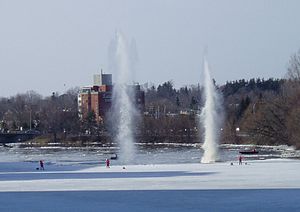| Revision as of 09:26, 28 December 2008 editTim Q. Wells (talk | contribs)6,214 editsmNo edit summary← Previous edit | Revision as of 21:56, 4 July 2009 edit undoVegaswikian (talk | contribs)270,510 edits Needs cleanup.Next edit → | ||
| Line 1: | Line 1: | ||
| {{references}} | |||
| {{importance}} | |||
| ] in ]]] | ] in ]]] | ||
| '''Ice blasting''' is the use of ] to break up ] in rivers, greatly aiding navigation systems. | '''Ice blasting''' is the use of ] to break up ] in rivers, greatly aiding navigation systems. | ||
| Line 6: | Line 8: | ||
| Ice blasting has a number of disadvantages. It is expensive and dangerous requiring highly skilled explosives experts. When blasting is occurring the public must be warned to keep their distance. The blasting has negative environmental consequences. Fish and other river creatures are inevitably killed and the river bottom is scarred. | Ice blasting has a number of disadvantages. It is expensive and dangerous requiring highly skilled explosives experts. When blasting is occurring the public must be warned to keep their distance. The blasting has negative environmental consequences. Fish and other river creatures are inevitably killed and the river bottom is scarred. | ||
| ⚫ | ] | ||
| == References == | |||
| {{reflist}} | |||
| ⚫ | ] | ||
Revision as of 21:56, 4 July 2009
| This article does not cite any sources. Please help improve this article by adding citations to reliable sources. Unsourced material may be challenged and removed. Find sources: "Ice blasting" – news · newspapers · books · scholar · JSTOR (Learn how and when to remove this message) |

Ice blasting is the use of explosives to break up ice in rivers, greatly aiding navigation systems. This is done during the spring when snow is melting and river ice is breaking up. There is always a chance that the ice flows could collide creating an ice jam creating a dam and blocking the river. The river, filled with melt water, will quickly flood and often cause damage to nearby settlements. Thus in most northern areas governments quickly act to break up the ice jams before they can do much damage. This is most easily done with explosives. These explosives may be planted from the shore, or in some cases by helicopter. In the large rivers of the Siberia the Russian airforce is sometimes called in to bomb ice jams.
Some districts, where flooding is especially common, do preemptive ice blasting. The city of Ottawa, Canada, for instance, blasts the Rideau River each spring to break up the ice.
Ice blasting has a number of disadvantages. It is expensive and dangerous requiring highly skilled explosives experts. When blasting is occurring the public must be warned to keep their distance. The blasting has negative environmental consequences. Fish and other river creatures are inevitably killed and the river bottom is scarred.